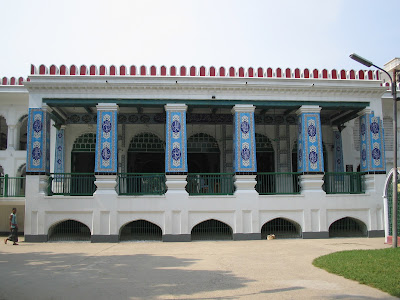 |
| Main gate of Bahadur shah Park |
History
Named after Queen Victoria, the park was created in the first half of 19th century at the initiative of Nawab Abdul Gani in the Sadarghat area of Dhaka on the ruins of an old building, called Antaghar, a clubhouse of Armenians then living in a large number in the neighborhood. The place got a special identity because, during the Sepoy revolt of 1857, some mutineers including a woman were hanged publicly on the branches of the trees at this spot. The park was renamed Bahadur Shah Park in memory of the last Mughal emperor in whose time the mutiny took place. For a long time after the mutiny, this place remained a haunted area and
even in broad daylight people feared to tread upon this ground. In the 1960s, Dhaka city Corporation renovated the park and converted it to a memorial in honour of the martyrs in the struggle for freedom.
Architectural significance
Indeed, Bahadur Shah Park
(former Victoria Park) is enriched with some architectural displays. There are
two entrances of Bahadur Shah Park.
Plenty of trees really make the place majestic. The sculptures in the park are
one of a kind. There is a tall memorial at the eastern side. It is an Obelisk
which commemorates the ascending of the throne of Queen Victoria
as Empress of India and British Empire. There is another
magnificent sculpture at the western part. It was built in the honour of the
martyrs. There is also an octagonal fountain in the middle of a star shaped
fountain in the park. It is a place of pride for our country. Bahadur
Shah Park now
attracts the young and the old, who come here to enjoy the peaceful
environment. Whether you are interested in the history of old Dhaka
or are simply looking for a place to take a relaxing stroll, Bahadur
Shah Park is a
delightful attraction in old Dhaka.
Activities
There were many institutions around the park. These are Jagannath University,
Kabi Nazrul College, City Corporation Mohila College, Shaheed
Suhrawardy College
Government Muslim
High School, Islamia
Government High school,
St. Gregory high school, St. Francis high school and Sunflower
High School, among many others. At
daytime, students of these institutions gather and gossip or study in the park
area and many health conscious people entered into the park for jogging and
walking both in the morning and in the afternoon. This fantastic attraction in Dhaka
provides travelers with the opportunity to look back into the turbulent history
of Bangladesh.
The park attracts some two thousand five hundred visitors including foreigners
each day and frequently sets the scene for cultural and religious festivals
including Bengali happy New Year (Pohela Boishakh). Every day more than 2,000
people including women and the elderly arrive there after and before dark to do
physical exercise and spend leisure. The hawkers are making business at the
same time.








